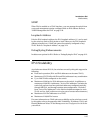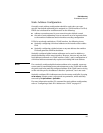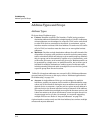
3-3
IPv6 Addressing
Introduction
Introduction
IPv6 supports multiple addresses on an interface, and uses them in a manner
comparable to subnetting an IPv4 VLAN. For example, where the switch is
configured with multiple VLANs and each is connected to an IPv6 router, each
VLAN will have a single link-local address and one or more global unicast
addresses. This section describes IPv6 addressing and outlines the options for
configuring IPv6 addressing on the switch. The configuration process includes
automatically or statically creating an IPv6 address and automatically veri-
fying the uniqueness of each.
IPv6 Address Structure and Format
Address Format
An IPv6 address is composed of 128 bits divided into eight 2-byte fields of
hexadecimal values. The full format is:
xxxx : xxxx : xxxx : xxxx : xxxx : xxxx : xxxx : xxxx
where each field delimited by a colon (:) is a set of four hexadecimal digits.
For example:
2001:0db8:0000:00A9:0215:60ff:fe7a:adc0
2001:0db8:0260:0212:0000:0000:0000:01b4
The hexadecimal characters in IPv6 addresses are not case-sensitive.
Address Notation
Leading zeros in each field can be omitted as long as each field is represented
by at least one value. The exception to this rule is when there is an uninter-
rupted series of zeros in one or more contiguous fields. In this case, the series
of zeros can be replaced by “::”, with the restriction that “::” can be used only
once in a given address. Applying this convention to the above examples
results in the following address notations:
2001:db8::a9:215:60ff:fe7a:adc0
2001:db8:260:0212::01b4


















